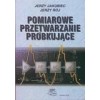- Out-of-Stock



ADMISSION
1. INTRODUCTION
2. ANALOG-DIGITAL PROCESSING SYSTEMS
2.1. MEASURING AMPLIFIERS
2.1.1. Requirements for measuring amplifiers
2.1.2. Replacement circuit of the amplifier input circuit
2.1.3. The basic layout of the measuring amplifier
2.1.4. Transfer of common voltage through the basic amplifier
2.1.5. Standard measuring amplifier system
2.1.6. Examples of integrated measuring amplifiers
2.1.7. Parameters of measuring amplifiers
2.1.8. Noise amplifiers
2.1.9. Replacement diagram of the measuring amplifier
2.1.10. The use of S and R terminals of the measuring amplifier
2.1.11. Analysis of the influence of parasitic elements on common voltage attenuation
2.1.12. Screening of the measuring amplifier inputs
2.1.13. Elimination of common voltage from the input circuit of the amplifier
2.1.14. Polarization of measuring amplifier inputs
2.2. ANALOG COMMUNICATORS
2.2.1. General description of the commutator
2.2.2 Analogue substitute circuit diagram
2.2.3. Reed switch
2.2.4. CMOS switches
2.2.5. Basic constructions of commutators
2.2.6. Examples of commutator solutions
2.2.7. Parameters of integrated commutators
2.2.8. Commutators with switched capacitors
2.3. PROGRAMMED AMPLIFIERS
2.3.1. Basic constructions of programmable amplifiers
2.3.2. Cascade connection of measuring amplifiers
2.4. SAMPLE / REMEMBER SYSTEMS
2.4.1. The way the sampling / reading system works
2.4.2. Basic configurations of sampling / recall systems, ch
2.4.3. Properties of sampling / reading systems
2.4.4. SHC sampling / storage system
2.5. CYFROWO / ANALOG. TRANSMITTERS
2.5.1. A general description of digital / analog processing
2.5.2. Properties of basic codes used in D / A converters
2.5.3. Basic types of D / A converters
2.5.4. Parameters of D / A converters
2.5.5. An example of a D / A converter solution
2.6. ANALOG / DIGITAL TRANSDUCERS
2.6.1. The quantization process
2.6.2. Basic solutions of A / D converters. AND
2.6.3. Parameters of A / D converters
2.6.4. An example of an A / C converter solution
3. PROGRAM PLAY IN THE SAMPLE TRANSMITTER
3.1. PLAYBACK ALGORITHMS
3.1.1. Software processing on the principle of reproduction
3.1.2. Decomposition of analogue processing models
3.1.3. Separation of static and dynamic properties of the converter
3.1.4. Playback algorithm
3.1.5. Dynamic errors of sampling processing
3.2. DETERMINATION OF UNCERTAINTY THE RESULTS OF PROCESSING PROCESSING
3.2.1. Introductory remarks
3.2.2. Parameters of the error value set
3.2.3. Uncertainty as a parameter of the error value set
3.2.4. The error model of the dynamic algorithm
3.2.5. The error model of the static algorithm
3.2.6. Algorithm uncertainty model
3.2.7. The uncertainty model of the playback algorithm
4. SAMPLE TRANSMITTER TRANSMITTER
4.1 PROCESS OF PROCESSING IN AN EXAMPLE SAMPLE TRANSMITTER
4.1.1. Parameters of the components of the transducer
4.1.2. The structure of the processing process carried out by the sampling transducer
4.1.3. Determining the values of the inverse model parameters
4.1.4. Adjustment of the sample voltmeter
4.1.5. Implementation of the processing process by a sampling voltmeter
4.2. DETERMINATION OF UNCERTAINTY OF SAMPLE SAMPLE
4.2.1. Sampling processing errors
4.2.2. Error model of the matching system and quantizer
4.2.3. The error model of the playback algorithm
4.2.4. The uncertainty model of the sample voltmeter
LITERATURE
KEEP THE BASIC DATES
No product available!
No product available!
No product available!
Switch mode power supply with 12V output voltage and 1A current. It has a DC 5.5x2.1 plug and an EU plug. The power supply has built-in overload, overvoltage and short-circuit protection. ESPE-1212-W2E
No product available!
LAUNCHING KIT FOR AVR I 51 - SELF-ASSEMBLY KIT
No product available!
No product available!
Panasonic Alkaline Power AAA battery (R3, LR03), voltage 1.5V, 4 pcs.
No product available!
No product available!
No product available!
9" portable monitor with touch screen. Equipped with mini HDMI interface for image display and USB for touch screen operation. High resolution 2560x1600 pixels. Waveshare 9inch 2560x1600 LCD
No product available!
No product available!
No product available!
Capacitive soil moisture sensor with analog output. The probe has a pointed tip, which allows it to be easily inserted into the ground
No product available!
Digital altimeter with barometer and temperature sensor, equipped with MPL3115A2 system with I2C interface. MOD-69
No product available!
No product available!
No product available!

